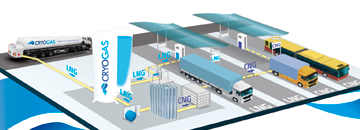See how an LNG station is constructed:
LNG (Liquefied Natural Gas) is a liquefied natural gas with high methane contents, converted into liquid for easier transport and storage in locations which are not covered by traditional gas networks. Natural gas is cooled down in a liquefaction facility to a temperature of -162°C, which reduces its volume by more than 600 times. Additionally, liquefied gas is stripped of moisture, carbon dioxide, nitrogen and heavier hydrocarbons. CH4 (LNG) is an odorless, colorless and non-toxic compound with a high octane number of approx. 130. Liquefied natural gas is a safe fuel, as it is lighter than air and evaporates quickly. It is enriched with odorous substances before reaching the consumer’s installation, and the application of detection systems allows for the very convenient and safe use of natural gas.
Natural gas in liquefied form – LNG can be effectively transported with tanker trucks to LNG regasification stations which are located in the vicinity of the consumers. It is an environmentally-friendly fuel preferred throughout Europe as an energy carrier for heat production. Replacement of other fuels, especially fuel oils and LPG to LNG brings about measurable savings and improves efficiency and operation of installations in the process of heat production.
See the refuelling procedure of an LNG station:


